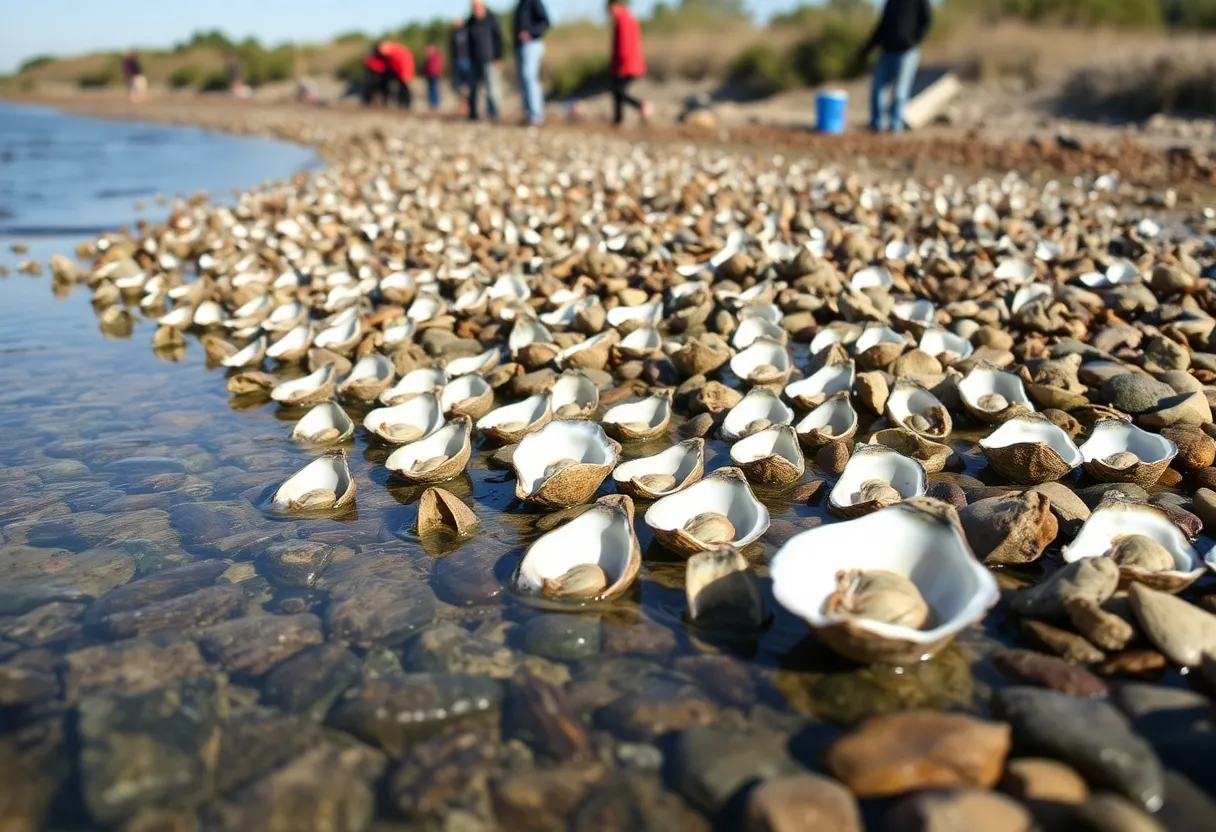News Summary
The Orange County Coastkeeper has launched a new initiative in Newport Beach aimed at restoring native oyster beds and addressing coastal erosion. Under the guidance of Kaysha Kenney, the project collects discarded oyster shells from local restaurants to provide a sustainable habitat for the endangered Olympia oyster, while also involving the community in efforts to stabilize eroding shorelines. This innovative approach not only aims to boost oyster populations but also enhances local marine ecosystems and water quality.
Newport Beach – A new environmental initiative has been launched by the Orange County Coastkeeper to restore native oyster beds along the coastline and address the issue of coastal erosion, utilizing discarded oyster shells. The project primarily focuses on reviving the population of Olympia oysters, which represent the only native oyster species along the West Coast and have been severely impacted by coastal development and overharvesting practices dating back to the Gold Rush era.
The effort, led by Kaysha Kenney from Orange County Coastkeeper, involves the collection of discarded oyster shells from local restaurants, including Bluewater Grill in Newport Beach. In addition to shells, leftover food bits are collected, which will decompose and provide nourishment for local animals when returned to the environment. These shells will undergo a mandated curing process in Irvine, California, to eliminate potential pathogens and residual food, lasting at least six months, in accordance with California regulations.
The cured shells will then be transported to the Seal Beach National Wildlife Refuge, where they will be incorporated into a “living shoreline” project. This innovative approach focuses on using marine life and vegetation to stabilize eroding shorelines, as opposed to traditional hard armoring solutions such as seawalls. The initiative is being developed in collaboration with California State University, Fullerton, and the U.S. Navy, with the ecological aspects led by Danielle Zacherl, a biology professor at Cal State Fullerton.
Ecological Benefits of the Initiative
Living shorelines provide a range of ecological advantages. They help stabilize coastal habitats, slow water velocity to facilitate sedimentation, filter excessive nutrients, and enhance overall water quality. Oysters, in particular, play a significant role in this ecosystem; a single oyster can filter up to 50 gallons of water each day, which contributes to improved water conditions and creates habitats for other marine species, including eelgrass.
Community Involvement
The project has also engaged local residents in Huntington Harbour, affectionately dubbed “oyster nannies,” who assist by hanging strings of discarded oyster shells from their docks. This method entices oyster larvae to settle and grow, which has already proven successful, with Coastkeeper retrieving over 700 baby oysters, commonly called “spat,” from these structures. These juvenile oysters were subsequently relocated to the Seal Beach site to further support the living shoreline venture.
Volunteer Opportunities and Future Plans
Volunteers are being sought for ongoing processes, including shell transport and the maintenance of oyster strings. The Coastkeeper organization plans to continue and potentially expand the project in the upcoming year. The program encourages residents to participate actively and has generated a competitive atmosphere among the community regarding who can collect the most oyster shells.
Background Context
Olympia oysters have faced significant threats over the past century due to human activities such as overharvesting and habitat destruction. Restoration efforts like this are crucial not just for reviving oyster populations, but also for enhancing coastal resilience against erosion and improving marine ecosystems. By combining community efforts with scientific research and practical application, the Coastkeeper organization is addressing environmental challenges in a way that fosters both ecology and community engagement.
This project exemplifies a growing trend in coastal management, where traditional approaches are replaced by innovative solutions that emphasize ecological integrity and community involvement, ultimately aiming for a sustainable and thriving coastal environment.
Deeper Dive: News & Info About This Topic
HERE Resources
Additional Resources
- LAist: Oyster Shells and Living Shoreline in Orange County
- LA Times: Dock Owners Collect Native Oysters
- OC Register: Recycling Oyster Shells for the Environment
- Wikipedia: Oyster
- Encyclopedia Britannica: Oyster

Author: STAFF HERE COSTA MESA WRITER
The COSTA MESA STAFF WRITER represents the experienced team at HERECostaMesa.com, your go-to source for actionable local news and information in Costa Mesa, Orange County, and beyond. Specializing in "news you can use," we cover essential topics like product reviews for personal and business needs, local business directories, politics, real estate trends, neighborhood insights, and state news affecting the area—with deep expertise drawn from years of dedicated reporting and strong community input, including local press releases and business updates. We deliver top reporting on high-value events such as the OC Fair, Concerts in the Park, and Fish Fry. Our coverage extends to key organizations like the Costa Mesa Chamber of Commerce and Boys & Girls Clubs of Central Orange Coast, plus leading businesses in retail, fashion, and technology that power the local economy such as Vans, Experian, and South Coast Plaza. As part of the broader HERE network, including HEREAnaheim.com, HEREBeverlyHills.com, HERECoronado.com, HEREHollywood.com, HEREHuntingtonBeach.com, HERELongBeach.com, HERELosAngeles.com, HEREMissionViejo.com, HERESanDiego.com, and HERESantaAna.com, we provide comprehensive, credible insights into California's dynamic landscape.





